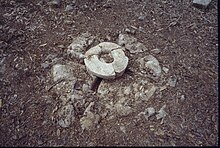Chultún
Chultún ( Yucatec Maya , plural chultunoob) is a cistern built by the Maya in pre-Columbian times. In the dry areas of the Yucatán Peninsula , especially in the Puuc region , they were primarily used to supply drinking water during the dry season . They can be found there in large numbers, such as over 300 Chultúns in Sayil . In the southern part of the peninsula, the Petén and adjacent areas, the Chultún occurs less often, often has a different shape with a side chamber and was used to store various goods (but possibly only for the nuts of the breadnut tree ) and perhaps to ferment alcoholic beverages used.

construction
The Chultún as a cistern was sunk into the relatively soft rock soil at the site of a planned platform. The shape is dome to bell-shaped, it has an approximately 1 meter long tubular access from above ("neck"), which initially served to remove the excavation, later it was the access to the stored water. The diameter is just enough for a slim person to slide through (40-65 centimeters). The cavity is between 2.5 and 3 meters high and measures around 6 meters in diameter. The floor area is usually a little irregular. When erecting the platform, on which mostly residential buildings were built, a 3 to 4 meter diameter radius was designed to be slightly inclined. A brick construction was built on the platform around the "neck", which is usually cut by four relatively narrow channels through which the water could run from the slightly sloping collecting surface into the Chultún, with larger objects such as leaves being kept away. In the center of the “neck” on the above-mentioned construction, a stone ring was placed, in the opening of which a stone plug was placed. The plug was only removed to remove water. The water was drawn off with special clay vessels, through the knobs of which strings were drawn, which made it possible to lower and raise it. The broken vessels can be found today at the bottom of the Chultún.
The inner walls of the Chultun were made waterproof with a thick layer of stucco. The water only reached a height of 1.5 to 2 meters during the rainy season, as shown by deposits on the walls. Often there are three-dimensional depictions of aquatic animals, especially frogs, on the stucco cladding.
literature
- Renée Lorelei Zapata Peraza: Los chultunes de la región serrana de Yucatán. in: Cuadernos de arquitectura Mesoamericana 5, 1985, pp. 17-24
Individual evidence
- ^ Alfredo Barrera Vásquez (1980): Diccionario Maya Cordemex Maya-Español-Maya . Ediciones Cordemex 1980. Mérida, p. 114.
- ↑ Dennis E. Puleston: An experimental approach to the function of Classic Maya chultuns in American Antiquity 36, 1936, pp 322-335
- ↑ Bruce H. Dahlin and William J. Litzinger: Old bottle, new wine: the function of chultuns in the Maya Lowlands, in American Antiquity 51, 1986, pp. 721-736
